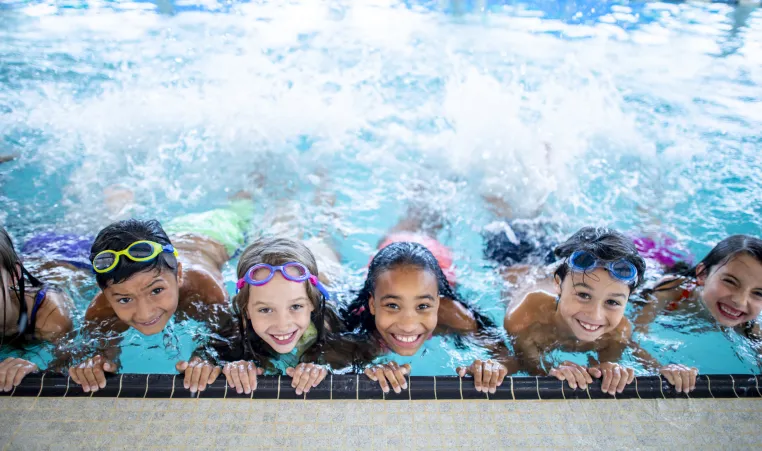
Nicole Bandura
Associate Executive of Facilities and Risk Management, YMCA of Bucks and Hunterdon Counties
May is National Water Safety Awareness month in the U.S. The YMCA, the American Red Cross, and recreational aquatics organizations across the country recognize the vital importance of educating the public on how to be safe in and around water. With summer just around the corner, May is the perfect month for everyone to think about how we intend to keep each other safe as we plan beach days, visits to backyard pools, and trips to beautiful lakes and streams our communities have to offer.
According to the Center for Disease Control and Prevention (CDC), drowning kills close to 4,000 people each year in the U.S. Drowning is the leading cause of death among children one to four years old, and each year, emergency rooms treat nearly 8,000 patients for nonfatal drowning accidents. Although we associate water safety and the inherent dangers with children, there are many adults who have yet to learn to swim or safely respond when they find themselves in the water. As the community’s leading provider in aquatics skill and safety programs, the YMCA seeks to provide education and opportunities for families to be safely confident around the water all year round.
Tips for All of Us
- Always swim with a buddy. We tend to imagine that a swimmer in distress will make a loud racket while in danger or physically compromised. In fact, the opposite is true. Swimming with at least one other person increases the likelihood that should anything happen to someone, there will be someone to help.
- Adults should always supervise children anytime they are around, near or in bodies of water. Accidents happen in an instant, and drowning can take place in even an inch of water.
- When purchasing new swimsuits for you and your children, consider bright colors and patterns that stand out in the water. Should an incident arise, the bright colors help to easily locate anyone struggling underwater. It is best to avoid blue swimsuits because many pool bottoms and walls are painted blue, and natural water bodies often appear blue because the water reflects the color of the sky.
- Review the rules. Follow the rules. When visiting a community pool or lake, be it public or private, the facility will likely have a list of rules posted for patrons. When visiting with your family, review the rules, and remind each other the rules are there to prevent accidents, injuries and deaths. As a family, you can also list out your own rules, and make sure everyone abides by them.
- Install and enable barriers when adults are not present. Backyard pools can be the most dangerous places for children and pets. Fences should be completed and locked when adults will not be present to supervise. Children, especially young children, often feel safe around their neighbors, especially if those neighbors have previously hosted them for fun times in their pool. Young children like to roam and explore their own backyards, and the worst-case scenario is they wander right into your pool. It happens and is 100% preventable. Pool owners can also install an alarm for whenever someone or something enters the pool. Stowing the inflatables and other pool toys that attract children will also go some distance to preventing this horror.
- Children and adults should wear life jackets when participating in water sports or boat ventures. You may not know how deep the water is. Your jetski may have jetski’d away without you. Your friends may not have noticed you fell off the boat. Even those of us with excellent swimming skills get tired treading water. Wearing a life jacket will buy time for someone waiting to be pulled from the water, or help provide floating breaks while trying to swim to shore.
- Encourage everyone to learn to swim. It’s the most important thing we can do to enjoy our time in and around the water. Children as young as one year old can begin to learn water survival skills. If you have or know children who have not yet learned to be safe in the water, it is now easier than ever to enroll children in aquatics courses. If you are or know an adult who would benefit from swim lessons, there could be some shyness or embarrassment. Adults who cannot swim are not alone, and many adults take swim lessons. Adults, especially parents, should be aware of the dangers of not knowing how to swim safely, and address those dangers by enrolling in a basic swim skills course immediately.
May is chosen as the month to raise awareness about water safety, but that does not mean May is the only month to address it. YMCAs across the country offer swimming and aquatics safety courses for all ages, all year round. Many Ys offer financial assistance programs and sometimes free basic water skill and safety classes to make sure all have access to learning these life-saving skills.
YMCA of Bucks and Hunterdon Counties operates aquatics programs with instruction for all ages at branches in Doylestown, Quakertown, Warminster and Fairless Hills in PA; and the Deer Path branch in Flemington, NJ. During the summer months, the Y also offers swim lessons at the Holland Outdoor Pool location. Please visit our aquatics page to learn more about programs or to contact a caring expert to answer questions and point you in the right direction. Financial assistance is available to those who qualify.
Here’s to having a wonderful, safe summer!
About the author:

Nicole Bandura serves as the Associate Executive of Facilities and Risk Management for YMCA of Bucks and Hunterdon Counties. Nicole holds a Bachelor's Degree in Exercise Science from West Chester University. Nicole has served the YMCA community for 9 years in the areas of Aquatics, Wellness, Facilities and Risk.
References:
McCue, J. (2021, Sept. 2) Water Safety. Nemours Children’s Health Network Blog https://blog.nemours.org/2021/09/water-safety/
Wurst, M. (2023) Summertime Water Safety for Kids. Lehigh Valley Health Network https://www.lvhn.org/news/summertime-water-safety-kids